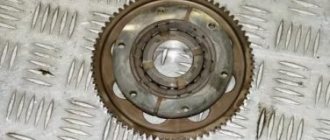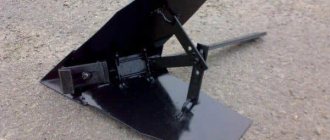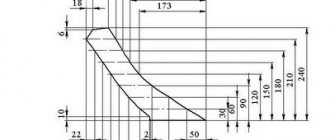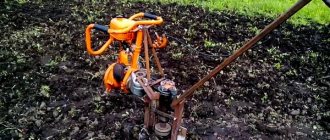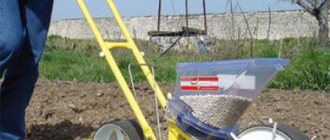Many farmers ask how to make a seeder for a walk-behind tractor. In modern agriculture, motor cultivators are increasingly used, which include various devices and designs. Such tools also include grain seeders mounted on a walk-behind tractor.
The seeder for the walk-behind tractor is designed for uniform distribution of cultivated seeds in the ground. The type and type of structures resemble tractor ones, only several times smaller.
How do seeders work?
The chain drive system aggregates with the rear wheels of the equipment. The seed hopper holds the volume of crop for several rows or beds. On some models there is a separate container for each row. Often the seeds are mixed with some kind of fillers or fertilizers.
Vegetable seeders are equipped with special brushes that loosen the seeds. At the outlet of the container there is a disk that opens a hole for the culture to exit.
The designs, as a rule, are suitable for almost any motor-cultivator, for example, the Neva, Oka walk-behind tractor, etc.
Seeders for walk-behind tractors are quite convenient in the sense that the speed mode for planting crops can be adjusted in advance. This is a big plus of the planter for motor cultivators and other units. Another advantage is that this tool can be installed on any type of walk-behind tractor.
For planters, there is a classification of sowing methods:
- privates;
- nesting;
- square-nested;
- dotted (accurate);
- scattered.
For different types of seeds, different models are used: vegetable, grain, universal. But for some cultures there is still an exception. These are sunflower seeds, corn and beans. The bunker system is most often used, but sometimes they resort to vacuum ones, which are used as mini-pneumatic planters.
A vacuum seeder is also a pneumatic seeder, a precision seeder, dotted. The vacuum seeder for the walk-behind tractor is SVTV 4-8. Its purpose is to sow vegetables and grains. Initially, the design is designed for 4 rows, but it can be converted into an eight-row one without radically changing the unit.
Pneumatic seeders are used to work with weighted walk-behind tractors. The set includes 4 removable drums that can sow 2 rows each. You can plant both small grains and large ones, such as corn. Sowing depth is up to 10 cm, row width is up to 70 cm.
A homemade garlic planter for a walk-behind tractor is used for planting bulbous species (garlic, tulip, onion). Farmers also use this seeder for vegetables. STV is an excellent garlic planter. SV-6, SVTV 4-8 - these models are vacuum. There is a special garlic planter specifically for garlic. The design includes small spoons that pick up the bulb and direct it directly into the furrow, which is prepared in advance.
But some models do not have plates with which the wheels dig into the soil and compact it. However, this attribute can be made with your own hands.
DIY manual corn seeder
The arrival of the summer season in rural areas is marked by the beginning of sowing , which begins mainly in May. Previously, such work was done manually, but with the advent of partial mechanization, this process was slightly simplified.
In particular, manual precision seeding drills have appeared, designed to evenly distribute seeds into the soil.
Using this device, you can sow not only a wide variety of vegetable seeds, but also sow lawn grass in the area.
The Russian agricultural machinery market offers many different models manufactured in Europe and the USA.
But, no matter what manufacturer is listed on the packaging, the main goal of these manual seeders is the same - to distribute the seed in the soil as efficiently and evenly as possible.
About the device
A manual precision seed drill, just like a garlic seeder, in its design features looks like a rather unpretentious invention . It consists of one or more containers where the seed will be located, a control handle and a frame located on wheels.
The wheels, which are located in front of the device, form holes or furrows, after which the seed from the hopper falls there, and the rear wheels fill the resulting hole with loose soil.
As we can see, the principle of operation is quite simple. In fact, you simply direct the unit over the area where you plan to grow various vegetable crops, and behind you there will already be holes with seeds.
At the same time, with the help of a manual seeder and a lawn seeder, you can plant not only seeds of lawn grass and vegetables, but also fill sand or fine gravel on icy and snowy paths in winter, so that you can safely walk on them without fear of falling.
Manual seeder for precision seeding
In general, the process of working with a manual precision seeder can be divided into three stages:
- Assembly process. First you need to install the control handle from the transport position to the working position, and then put the rear wheel on the axle (if the unit used consists of two wheels). If necessary, we adjust the marker.
- Carrying out regulatory actions. Depending on what kind of crop the seed will be used, the installation of a specific disc in the bunker will depend. It is difficult to confuse them because they are all properly labeled.
- The depth of the share must also be adjusted according to the specific seed.
- Carrying out sowing work. After we put the unit into action, torque is transmitted from its front wheel to the disk through a belt or chain drive. This disk captures the seed from the container, and the ploughshare forms the desired depth of the hole.
- The marker is responsible for ensuring that the row of seeds planted is level , so he forms a line on the ground for the next row.
For convenience, as well as for uniform distribution of seeds in the soil, it is recommended to sow the first row along predetermined contours.
You can drive two pegs along the edges, connecting them with rope or thread.
Thus, following parallel to this border, you will get a very even and visually beautiful row.
Models, specifications and prices
Manual precision seeders are designed to speed up the sowing process.
Therefore, few people question the feasibility of purchasing them.
However, to make the right choice, you need to pay attention to several main points:
- The cost of the unit, which can vary greatly among different manufacturers.
- The total number of containers for seed material. Again, the more data bins, the higher the cost of the device.
- The depth of the holes being formed will depend on the crop whose seeds are planted.
- The weight of the device also plays a role, especially when working over large areas
- The presence in the unit of additional devices that make the sowing process more convenient (marker, plow for filling seed, etc.).
There are quite a lot of different models on the market from manufacturers, which differ from each other in several design aspects.
In total, there are several companies that are most widely represented on the Russian agricultural machinery market.
Newtechagro
The device from this company is a single-row type of unit designed for planting beets, cabbage, onions, carrots and other vegetable crops. The average cost for such a seeder is about 65 thousand rubles.
SOR-1/1
SOP-1/1 from the Rosta company also applies to single-row devices.
The design may include a bushing or brush sowing unit, with a row marker of half a meter.
The seed container holds about two buckets of seed, which is quite enough for a small garden.
The price for such a unit is only 2-3 thousand rubles.
1001-B
model 1001-B has six interchangeable discs for a wide variety of crops. In total, using this seeder, you can plant more than 28 different vegetable crops.
The design of the unit contains a special adjusting screw that allows you to change the depth of planting of the material.
Specifications:
- total weight – 4 kg;
- dimensions (packed) – 350mm/200mm/700mm;
- planted crops - beets, carrots, onions, peas, spinach, etc.
The cost of this unit is about 8 thousand rubles.
SR-1 and SR-2
Models SR-1 and SR-2 from the one already mentioned also deserve special attention.
Structurally, they are somewhat different from typical manual precision seeders, because their design uses a roller, and not a rear wheel, like most models. SR-1 has a mass of 4 kg, and SR-2 weighs at least 18 kg.
In general, these devices are very similar, they differ only in size and cost - the first model will cost 4 thousand rubles, and the second about 7 thousand.
MSK
Models of the MSK series from the same company differ in that their design does not have a control handle.
The seeder is connected to a regular shovel handle, after which the sowing process takes place. At the same time, the average productivity of these units is about 0.2 hectares per eight hours of operation.
The cost of these models varies from 7 to 15 thousand rubles.
AL-KO US 45
The AL-KO US 45 model from a German manufacturer can be used throughout the year.
In summer, you can use it to plant various vegetable crops and sow lawn grass, and in winter, if you don’t have a Foreman, Patriot, Husqvarna, Champion, Huter or any other snow blower, you can sprinkle gravel and sand on an icy and snowy surface.
Specifications:
- working width – 450 mm;
- total number of holes – 23 pieces;
- Hopper volume – 24 liters;
- dosage – adjustable;
- wheels – present in the amount of two pieces (plastic);
- case material – plastic;
- total weight – 3.5 kg.
The cost of this manual seeder is about 3 thousand rubles.
In general, there are many different modifications on the market, so the farmer has plenty to choose from.
In particular, he can choose a drum or disk unit, a belt or chain drive, as well as a standard or extended configuration of the device.
The unit pays for itself quite quickly - almost in one season.
This is explained by the fact that partial mechanization of the process makes it possible to carry out sowing work in an accelerated mode, which makes it possible to sow as much area as possible.
Do-it-yourself garlic cutter for walk-behind tractor
In order to make a garlic planter for a walk-behind tractor with your own hands, you will need:
- wooden boards (metal tools add extra weight to the unit, making the work of the walk-behind tractor heavier);
- brush wheel (driven by a chain drive);
- a shaft with a chain connected to the front wheels of the cultivator;
- metal layer
You need to build a box from the boards, which will later become a bunker. A wheel with seeds is installed at the back of the box. It can be adjusted to suit the crop size.
A metal plate is attached to the bottom frame of the garlic planter, which plows the soil under the rows. The plate digs trenches for planting garlic. This type of planter can be considered universal.
A homemade garlic seeder for a walk-behind tractor is quick and easy to assemble. But for assembly accuracy you need to use drawings and diagrams. They indicate the exact dimensions and diameters of the unit, and this will increase the accuracy of sowing.
Step-by-step instructions for creating a garlic planter for a walk-behind tractor with your own hands are presented in the video. Seeders for walk-behind tractors have occupied an honorable place among agricultural equipment for many years. With their help, row planting of garlic, wheat, corn, rye, lentils and other crops is carried out.
It is advisable to use a manual seeder in medium-sized or small areas. For a large plot of land, it is advisable to use a self-made seeder for a walk-behind tractor. Any of these devices optimizes the process of sowing crops and improves the uniformity of seedlings.
Depending on the plants being planted, there are several groups of seeders:
- Combined. They have special devices for applying fertilizers to the soil.
- Universal. For planting various crops.
- Special. Sowing of certain plants is carried out.
A seeder for a walk-behind tractor can be purchased in specialized stores or made independently, following the instructions in the photos and drawings. A homemade option will save money on the purchase of a factory unit.
Having studied the algorithm of actions according to the presented drawings, you can make sure that making a seeder yourself will not be difficult. The use of this agricultural device will save the gardener’s energy, increase labor productivity and improve the quality of sowing.
Corn seeder: types, how to make it yourself, photo
A corn seeder is an indispensable tool that saves time and physical effort in planting corn seeds. Thanks to this technology, the productivity of vegetable crops increases. More detailed information about the planter is discussed below.
What is a corn planter?
A planter is a mechanism used to sow seeds into the soil. Before they were invented, sowing was done by hand, the grains were scattered as horizontally and evenly as possible.
The advantage of mechanical seeders is more precise planting of seeds in depth and distance from each other, which undoubtedly increases the yield and makes the harrowing procedure subsequent after sowing unnecessary.
The principle of operation of the planter is that it feeds seeds into the sowing apparatus, which places them at the required depth and at the required interval, after which the sowing is completed by a specially designed planting mechanism.
When using the planter on unprepared soil or over mulch, discs are installed directly in front of the opener, which cut the residue from the previous harvest and make landing slots to lighten the load on the skid opener.
Kinds
The corn planter can be of different types and designs, this is due to the characteristics of its use, mainly the size of the plot or farm where the corn is sown. The following is a discussion of the types of planters.
Important! The sowing rate is regulated in accordance with the instructions for the unit in the range from 25,000 to 100,000 per 1 ha, sowing depth - from 4 to 20 cm.
Seeder SUPN-8
It has a universal purpose, that is, it can be used for sowing not only corn, but also other grains.
It is equipped with a dotted pneumatic hinged structure, which makes it possible to sow seeds in rows at a distance of 50–60 cm. Together with the introduction of grains into the soil, it is capable of fertilizing crops.
SUPN-8 is equipped with 8 sowing sections located on suspensions, as well as 4 fertilizer sowing sections designed for applying fertilizers.
Seeder for walk-behind tractor
The walk-behind tractor is a self-propelled device with one axle, essentially a type of mini-tractor, inferior to the latter in size and power. In the case of a walk-behind tractor, the seeder is an additional unit in the form of a hinged element, necessarily equipped with a grain calibrator for the possibility of its universal use.
The depth of grain placement in this type of seeder ranges from 1 to 5 cm, the distance between rows is from 15 to 30 cm, with the possibility of simultaneous processing of 2 to 4 rows. A corn planter for a walk-behind tractor can be either factory-made or home-made.
Seeder for mini tractor
As already mentioned, a seeder for a mini-tractor is an enlarged copy of a planter for a walk-behind tractor.
It is also equipped with a seed calibrator; with the help of appropriate adjustments in accordance with the instructions, it can be configured for sowing corn.
Unlike a walk-behind seeder, it is applicable for a larger sowing area, allows you to sow grains to a slightly greater depth (up to 8 cm) and has a wider range of row spacing - up to 70 cm.
Manual seeder
The easiest to use unit for sowing corn, designed for use on small garden farms.
It consists of a hopper for loading seeds, a grain metering sleeve, a seed tube, a chassis, including wheels and a frame for attaching other elements of the mechanism.
Important! If
a manual seeder is equipped with several seed bushings, this will allow it to be used not only for sowing corn, but also other crops.
Rules and criteria for choosing a finished model
When choosing a particular type of seeder and its model, in addition to the area of the area to be sown, it is necessary to take into account such parameters as the accuracy of sowing in width and depth, with the ability to control these indicators, as well as the simplicity of the design, the reliability of the unit and its components. Of course, the versatility of the model and the possibility of simultaneous application of fertilizers to the soil play an important role. Finally, the price of the device plays a role. By comparing all these criteria and the importance of each of them in each specific case, you can choose the best option.
How to make a corn seeder with your own hands?
An alternative to buying a corn planter is to make a homemade planter. Here, in terms of materials and manufacturing methods, folk imagination is wide. Let's consider several options for making a seeder.
Materials and tools for work
To implement homemade production you need:
- plastic transparent container for grains in the shape of a jar;
- a bolt on which the seed tank rotates while the seeder moves;
- plastic pipe, comparable in length to the width of the seed container;
- a metal pipe of slightly smaller diameter than a plastic one;
- two washers for fixing the tank;
- a lid from a tin can, here it will serve as a lid for a jar of seeds;
- aluminum wire;
- wooden handle;
- hoe.
Step-by-step manufacturing instructions
Manufacturing instructions:
- Accurately measure the center of the seed container and drill a through hole.
- The lid of the tin can will serve as a valve to prevent the seeds from spilling out. To do this, the lid is cut out slightly larger than the hole for filling the seeds; it should be secured with aluminum wire so that the lid opens and closes freely during rotation.
- Place a plastic tube in the center of the can to prevent the can from compressing when the bolt is tightened.
- Insert a metal tube inside the plastic tube to form a bearing.
- Insert a bolt and nut into the metal tube and tighten with two washers.
- Using a hot nail, make two holes in the side of the grain container. The hole size should be equal to the size of the corn kernels.
- Using a wooden handle will make the seeder more convenient to use.
- The hoe will cover the sown seeds with soil. It must be bent and attached to the handle.
There is also a second option for making a planter of a more complex design, applicable both for sowing manually and using a walk-behind tractor.
The materials for its manufacture are more durable:
- steel sheets 2.5 mm thick for making a frame measuring 85x78 mm;
- vomer;
- as a reservoir for seeds - a galvanized steel box;
- an organic glass lid for covering the seed container, a furniture hinge and a latch;
- as a shaft for sowing - an aluminum tube with a diameter of 28 mm;
- M5 bolts, M6 screws;
- brush;
- two wheels.
Manufacturing instructions:
- Drill 3 rows of holes of different diameters in the sowing shaft, corresponding to the caliber of the seeds.
- Configure the frame according to the dimensions of the seed tank.
- At the bottom of the sides, drill holes with a diameter of 28.05 mm into which to insert the sowing shaft.
- Secure the grain box to the frame with bolts, and the brush, which regulates the sowing density by its vertical vibrations relative to the shaft, under the tank with screws.
- It is necessary to give the desired configuration to the truncated trapezoid of the seed container and the shaft holes.
- Attach the lid to the top of the tank using a furniture hinge and equip it with a latch.
: how to make a corn seeder with your own hands
When sowing manually without a walk-behind tractor, you must also independently make furrows for sowing grains. However, even when working with a manual seeder, the gardener’s energy is significantly saved, labor productivity and the quality of sowing are increased, and a homemade corn seeder will save money on the purchase of a factory unit.
DIY seeder for walk-behind tractor
Making a universal seeder for a walk-behind tractor with your own hands will not take much time. This design consists of several main parts:
- pairs of wheels;
- seeding roller;
- two bearings;
- seed box;
- handles with bracket;
- pairs of brackets for fixing the opener.
The seed box is made of boards (up to 15 mm). The structure is closed using steel overhead bottoms. The longitudinal and transverse walls are fastened using self-tapping screws, steel angles and tenons. Wooden linings 15 mm thick are attached to the lower part of the walls.
Semicircular cutouts are made in the overlays and on the walls. They are designed for mounting the seeding roller. Mounting brackets are pre-installed on them.
Rubber plates are fixed in the inclined bottoms to drop seeds from the cells.
The diameter of the wheels of a universal seeder for a walk-behind tractor is 200 mm. The size of the hubs is 60 mm, they have holes equal to the diameter of the roller.
To create the opener, 1.5 mm steel is used. It is fixed to the brackets.
The seed planting depth is adjusted by re-fastening the opener in the holes on the bracket.
Another bracket is fixed behind the seed box. It provides a connection between the homemade structure and the walk-behind tractor. For a better understanding of the algorithm for making a seeder with your own hands, see the drawing.
Do-it-yourself manual corn seeder - Metalist's Guide
Seeder - equipment for sowing seeds (grain) into the soil.
Before their appearance, seeds were sown in the ground simply by hand - using the method of uniform and, preferably, accurate horizontal scattering.
The main advantage of mechanical seeders is the uniform placement of seeds into the ground in depth and distance, which does not require additional surface harrowing after sowing.
You can buy, rent, or make your own corn seeder.
DIY seeder for walk-behind tractor. Drawings, photos, video descriptions
- DIY seeder for walk-behind tractor
- Drawings of a seeder for a walk-behind tractor
A grain seeder for a walk-behind tractor belongs to the category of agricultural machines used to evenly plant seeds into the soil. Before the invention of the seeder, crop seeds were scattered manually, as a result of which the required seeding density was not achieved.
https://www..com/watch?v=hrE-ReYAINY
In addition, planting seeds by hand requires a lot of physical effort.
Economically, manual sowing is not justified: scattered seeds fall unevenly onto the soil, and much more is wasted than when using a seeder.
Also, manual planting leads to uneven distribution of seeds, as a result of which the soil is quickly depleted.



